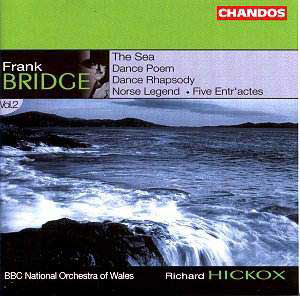I missed volume 1 of this series. However going by
the critiques of colleagues the series launched auspiciously with an
elementally remorseless Enter Spring as its centrepiece. This
is his greatest work - a single movement nature symphony as ineluctably
compelling as Alwyn's Hydriotaphia, Lambert's Music for Orchestra,
Rubbra's Eleventh or Havergal Brian's Symphonia Brevis.
The two dance works on this CD were coupled on a late
1970s Lyrita LP in performances by the LPO conducted by Nicholas Braithwaite.
They were revelatory events full of sweep and panache aided by the LPO's
virtuoso precision. The BBC Welsh put across all of the propulsive power
of those now long gone (and of course unissued on CD) interpretations
and only lack the last veneer of coordination and definition. They are
recorded as well as the LPO. The Dance Rhapsody is an
eruptive dionysiac work with strange premonitions of Nielsen and even
de Falla. Though nowhere near as revolutionary (parts of it sound Elgarian)
the instinctual spark derives from the same arousal and charge as Grainger's
ballet The Warriors.
The Entr'actes soothe and tickle, lilt
and sing. They are gentle unassuming creations which fit well alongside
the acreage of light music created by British composers during the first
half of the 20th century though standing in the Royal Enclosure by comparison
with the tired generality of much of this output. The Norse Legend
(originally for violin and piano) is another light and slight
genre piece.
The Dance Poem stands closer to the chill
of There is a Willow and though broadly contemporaneous with
the idyllic Summer it is far distant from the direct romantic
giddiness of the Dance Rhapsody. Although there is at least one
eruption it is far more knowing; rather like the rollicking climax that
tops off the tango movement of Samuel Barber's suite Souvenirs.
There are a surprising number of Baxian fingerprints too. The episodes
in the Poem are: The Dancer; Allurement; Abandon;
Tenderness; Problem; Disillusion. Does this chart
the course of an affair turned to ashes?
The Sea, the work that with Enter
Spring, bowled over the young Britten, was written in Eastbourne,
the same seaside town where Debussy had completed his La Mer.
Surely Bax was influenced by this work in his Tintagel - listen
to 2.10 and 3.04 tr. 9. Is that a quote or what? The Bridge work is
lucidly textured avoiding the wash and swell of impressionism; instead
painting in broad clear swathes of melody. This is a remarkably fine
performance to put alongside those of Groves/RLPO (EMI, 1977) and Handley/Ulster
(Chandos, 1980s). Most impressive of all is Hickox's way with the Storm
movement (tr. 12) with the loud crash of combers and the scattering
smithereens of spray and spume. In all this the details of the harp
part are not lost.
There is still plenty of Bridge territory to cover
in later volumes including the two major concertante works: Phantasm
for piano and orchestra and Oration - Concerto Elegiaco for cello
and orchestra, never mind the overture Rebus.
Notes are by leading Bridge authority, Paul Hindmarsh.
Every detail of this production speaks of the most exalted qualities.
Rob Barnett
EARLIER VOLUME IN BRIDGE ORCHESTRAL SERIES
Vol.
1: Isabella, Enter Spring, Mid of the Night, Two
Poems. BBCNOW/Hickox Chandos CHAN 9950


